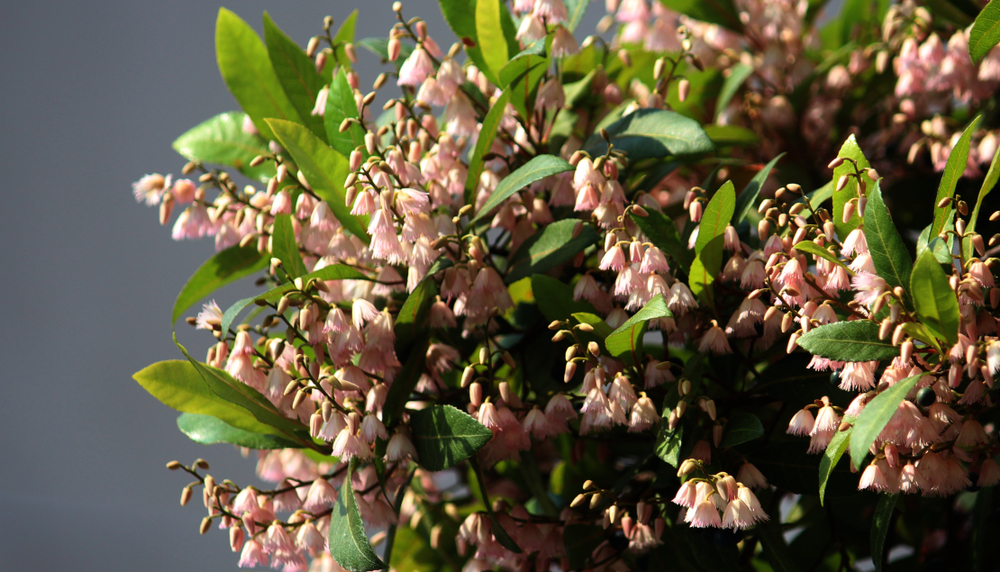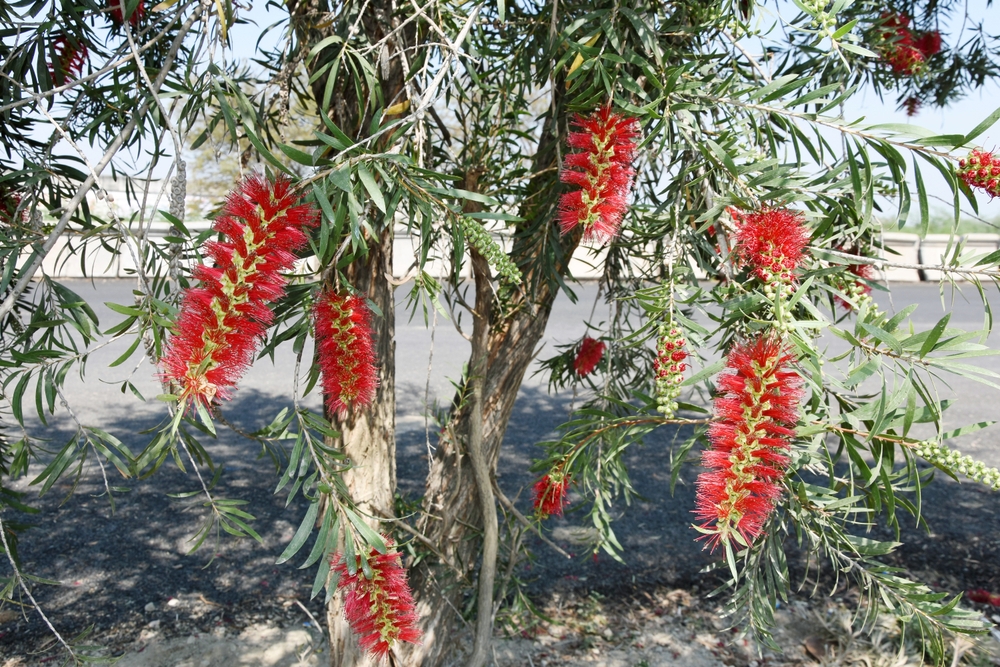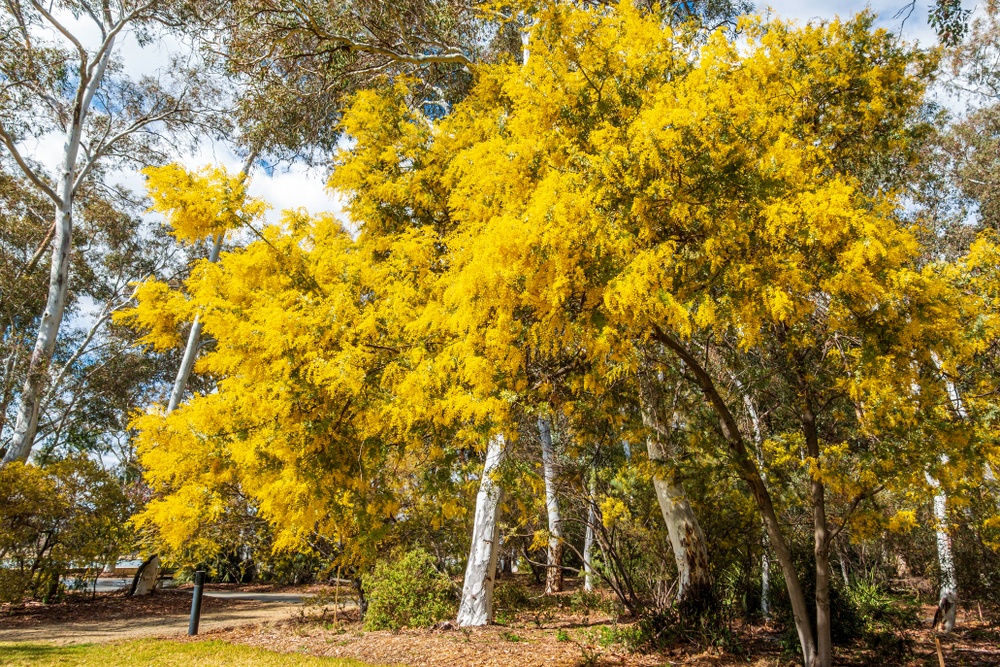The 17 Most Popular Native Australian Trees

Australia has over 24,000 species of native plants and trees, and they not only provide shade and enhance the aesthetics of a landscape, they also provide food and shelter for a range of wildlife from bees and koalas to birds and frogs. Here are 17 of the most popular native Australian trees.
1. Banksia tree (Banksia)
The Banksia is one of the most iconic Australian native trees and shrubs and was discovered by Sir Joseph Banks in 1770, who was one of the first Europeans to collect specimens of these plants. Banksias are stunning and versatile and come in various sizes, from low shrubs to tall trees, and there are now over 170 species in Australia. They are easily recognisable by their serrated leaves and flower spikes, which can be yellow, orange-red or greenish-white, and many species flower over autumn and winter. As the flower heads dry up, they darken and transform into a woody ‘cone’. These contain the seeds, which are released when the cone is burned or dried. Banksias thrive in a sunny location in sandy, well-drained soil and are drought-tolerant once established.Their flower heads also contain nectar which attracts bees and butterflies.
2. Black Sheoak (Allocasuarina littoralis)
The Allocasuarina is a native evergreen Australian tree that stands out for its slender, needle-like foliage and distinctive cone-like fruiting structures known as ‘Caspers’ or ‘she-oak cones’. However, this tree is not one of the small Australian native trees, as it can reach over ten metres in height, which is why it is one of the most popular fast growing Australian native trees. It is hardy and suitable for both coastal and inland areas and its showy, red flowers bloom in spring. It tolerates frost and a wide range of soil types other than soggy and sandy soils, and it is drought-resistant when mature. Regular pruning will enhance its health and appearance. This tree also has an extensive root system when established, so it should not be planted near paths, drains, buildings, etc.
3. Blueberry Ash tree (Elaeocarpus reticulatus)
This is one of the more popular evergreen small Australian native trees, although it can reach 15 metres in height, depending on growing conditions. It is a strikingly beautiful tree with a dense crown of foliage. Flowers appear in spring and summer and then become berries that last through winter. The Blueberry Ash needs little maintenance to survive, grows in a range of light intensities – from shade through to full sun – and tolerates low-nutrient and dry soils (although it performs best when well-watered). However, it won’t tolerate frost.
4. Bottlebrush tree (Callistemon)
The Bottlebrush tree has vibrant, brush-like flowers in various shades of pink, red and yellow, creating a ravishing display of colour. Beyond their visual appeal, the unique flowers of these native Australian trees are a magnet for nectar-feeding birds such as lorikeets and honeyeaters. In addition to their alluring flowers, Callistemon trees have evergreen foliage, which consists of slender, pointed leaves so are ideal for providing garden shade. They thrive in both inland regions and coastal areas, and their hardy nature makes them suitable for various soil types.
5. Bottle tree (Brachychiton)
The Bottle Tree is a distinctive native Australian tree known for its impressive size, attractive foliage, and showy flowers. It is one of the popular Australian native deciduous trees and has a striking appearance for both landscaping and ornamental purposes. Some species can grow up to 20 metres tall, while some shorter ones only grow to around seven metres. The tree canopy is also quite broad and dense with large glossy leaves. Although it’s one of the more common deciduous Australian native trees and sheds its leaves annually, during spring and summer it puts on a spectacular display of bell or tubular-shaped flowers ranging in colour from shades of red and pink to vibrant orange. This tree is drought-tolerant, so limited watering is needed once established.
6. Dwarf Fan Palm (Livistona muelleri)
Native to the Northern Territory and the Cape York Peninsula, this is one of the more popular Australian native palm trees that grows to a height of 16 to 25 metres but remains much smaller in gardens, where it can reach up to four metres. Orderly and ornamental, it has a brown trunk, bluish-black fruit and large fronds that tightly radiate in a fanning cluster atop the trunk. Red flower heads emerge annually, offering a vibrant display. Dwarf Fan Palms require little care, although in cooler locations they should be relocated indoors during winter. Read more about wonderful palm trees for your Australian garden.
7. Grevillea
One of Australia’s favourite native Australian trees, Grevilleas range from sprawling ground covers to the towering Silk Oak. They are part of an ancient plant family called Protaceae. This is a diverse, native Australian tree with over 350 species that are adapted to a range of habitats, grow to a range of sizes, and are suited to both native landscapes and ornamental gardens. Adaptive, beautiful and versatile, the leaves are typically small, narrow, and arranged in alternate patterns along the branches. Flowers can range in colour from orange, red and pink to white, purple and even black in some species. They may be arranged in spikes, clusters or bottlebrush-like shapes, and they often attract a variety of pollinators, including bees, birds and butterflies. Many species flower through the cooler months, brightening up a winter landscape. Care-wise, they are hardy and easy to maintain, but prefer full sun, free-draining soil and regular pruning.
8. Gum tree (Eucalyptus)
In terms of native Australian trees, gum trees are quintessentially Australian and home to some of our most iconic wildlife — like the koala! There are over 800 different species of Eucalyptus, and the flowers they produce have nectar that attracts a wide range of native bee species as well as large, colourful birds. They are renowned for their distinctive bark, which sheds in long strips, revealing a stunning array of textures and colours. From rough, fibrous barks to smooth, pale trunks, each species showcases its own exquisite pattern. Eucalyptus trees also have aromatic leaves, which release a distinct, refreshing scent. In terms of care, gum trees like full sun and well-draining soil. They grow best in temperate climates as they can’t tolerate frost when they are young. However given their tall mature heights, when planted in highly reactive clay soils they can contribute to soil expansion and contraction, causing movement in civil structures. They also shed branches and often significant volumes of leaf litter in dry conditions. Therefore consideration should be given to the species, estimated mature height and its proposed location when planting.
9. Illawarra Plum tree (Podocarpus elatus)
This is one of the popular Australian native fruit trees that is widely prized for its flavourful and nourishing fruit. The small, spherical plums have dark purplish-black skin and ripen in late summer to early autumn. Rich and juicy, the fruit’s flesh has a distinctive blend of acidic and sweet flavours. It can grow up to 12 metres and has long, slender evergreen leaves that are deep green in colour. The Illawarra Plum tree can grow in partial shade and full sun and needs well-drained soil. However, this hardy tree shows resilience towards salinity (so great for coastal regions) and adaptability across varied climatic conditions. Both the male and female species need to be planted for fruit production.
10. Lemon Myrtle tree (Backhousia citriodora)
These beautifully scented native Australian trees look gorgeous in any Australian garden and attract birdlife and butterflies. It has fresh, lemon-scented foliage and blooms with small, fluffy white flowers in summer. It can grow to eight metres in sunny garden sites and up to 20 metres in its natural habitat. It grows best in full sun and in free-draining soil rich in organic matter, although if your climate is hot and dry, you may want to grow it in the shade. Layer mulch or compost around the base to give it a boost. Pruning regularly will promote compact growth.
11. Lilly Pilly tree (Acmena)
The Lilly Pilly is a native Australian delight with thick, dense leaves that can be used as a privacy screen or an ornamental accent. In terms of weeping Australian native trees, the Weeping Lilly Pilly will tolerate drought and the occasional over-watering. Glossy, evergreen foliage and clusters of colourful berries make it a popular choice, and some species have attractive bronze or reddish new growth, which adds further visual interest. Flowers are small and fluffy in shades of white to pale pink. They attract bees, butterflies, and other pollinators. These develop into edible berries. They are fairly hardy, but like fertile soil with plenty of moisture. They should also be protected from cold or drying winds.
12. Native Frangipani tree (Hymenosporum flavum)
Commonly known as the Native Frangipani (it’s not related to the exotic form), this tree bears highly fragrant flower clusters that start out cream and turn yellow. A rainforest tree native to Queensland and New South Wales, its large, glossy leaves give it a beautifully exotic look. Growing to eight metres in ideal conditions, the larger versions can reach 20 metres, so bear that in mind if you need it for a backyard garden! It provides a lovely canopy as well as attracting birds and native bees. In terms of care, keep them out of strong winds as their branches can be brittle. It prefers well-drained and nutritious soil, but can tolerate various soil types. It can be grown in part-shade, but will thrive in a full-sun position.
13. Paperbark tree (Melaleuca quinquenervia)
These iconic native Australian trees have around 300 species in their genus. Shorter versions can grow to eight metres, while taller ones can grow as high as 25 metres. Regardless, this tree certainly captures attention, as one of its defining characteristics is its distinctive bark, which peels away in thin, papery layers. Displaying an enchanting palette of colours from a rustic reddish-brown to a creamy white, the foliage of the Paperbark tree can vary among species, but is generally comprised of narrow, needle-like leaves. Their flowers are also striking and often appear as fluffy, bottlebrush-like spikes in shades of pink, cream or yellow, which attract insects, birds and other pollinators. Care-wise, it prefers dry, well-drained soil and sunny to lightly-shaded conditions.
14. Pine tree (Casuarina equisetifolia)
Native to the northern parts of Australia, Southeast Asia and the Pacific Islands, this is an evergreen tree also known as the Horsetail Tree, She Oak, Whistling Pine Tree, Australian Beefwood, Coast Ironwood and Coast Casuarina. The word ‘equisetum’ translates to ‘horse hair’ in Latin. The species name was given to this tree because of its thin, drooping branches that resemble a horse’s tail. It is one of the more popular Australian native pine trees and can reach a height of 15 metres. It has low water requirements and is tolerant of most soil types, as long as it is well-draining. The species also has many environmental uses due to its high wind tolerance, so it is often used as a windbreak for livestock or crops. Its soil salinity tolerance also makes it suitable for erosion control in coastal areas.
15. Red Bloodwood tree (Corymbia gummifera)
This resilient and iconic native Australian tree is known for its distinctive bark and its flowers, which are typically found in clusters of red, pink or cream. The foliage of the Corymbia tree is also remarkable and ranges from vibrant green to bluish-grey. Leaves are glossy and typically elongated and lance-shaped. Endemic to eastern Australia, this is one of the large native Australia trees that can grow up to 35 metres. It is also very adaptable, so an ideal choice for both urban and rural landscapes. In terms of care, it prefers moist, rich soil but will also grow well in poorer sandy soils. Eucalypts require very little attention once established, however, they will produce more leaves and flowers if fertilised.
16. Smooth-barked Apple tree (Angophora costata)
Also known as the Sydney Red Gum, this tree is native to the coastal regions of eastern Australia. It is one of the more popular Australian native flowering trees and is widely cultivated for its ornamental value. It has attractive flowers and striking bark, which is typically smooth and orange-brown and peels away in thin, papery layers. As the tree ages, the bark may develop deep grooves, which adds further texture and visual appeal. Its foliage is also beautiful, with small, oval-shaped leaves arranged in alternative patterns along the branches. In terms of care, it prefers well-drained soils that are rich in organic matter and full sun to partial shade, and is drought-tolerant once established. However, it should also have plenty of room to grow, as it can reach a height of 15 to 30 metres and a spread of 10 to 15 metres.
17. Wattle (Acacia)
Close to 1000 species of Wattle are found in Australia, and it is one of the most iconic trees you can grow in your garden. In fact, the Golden Wattle (Acacia pycnantha) is Australia’s national flower. It is one of the fastest growing Australian native trees and has feathery foliage and vibrant golden flowers that burst into radiant yellow blooms with a sweet fragrance. They exhibit diverse growth habits and can thrive in various environments, including in free-draining soil in tropical climates. Once established, they are very low maintenance but prefer a sunny position (although they can tolerate partial shade). Wattles also provide food, shelter and habitats for birds and are a great source of pollen, so they will attract native bees.
References
- Jamie Donovan, 2023, AGuide to Australian Native Trees, Lawn
- 2023, 9 Australian Native Plants and Trees to Attract Wildlife and Bees to your Apartment Balcony or Garden, WWF
- Mark Thompson, 2023, Guide to Australian Native Trees, expertEasy
- 2023, Smooth-barked Apple (Angophora costata), Sequoia Valley Farms
- 2023, Casuarina equisetifolia – Australian Pine, The Seed Vine
- Jamie Donovan, 2022, How To Grow A Banksia Tree, Lawn
- 2023, Allocasuarina littoralis – Black She-oak, Gardening with Angus
- 2023, Corymbia gummifera, Wikipedia
- 2023, Bottlebrush (Callistemon) Trees, Plants & Flowers – 2018 Growers Guide, Ozbreed
- 2023, Hymenosporum flavum – Native Frangipani, Specialty Trees
- 2023, Grevilleas, Daleys Fruit
- 2023, Backhousia citriodora – lemon myrtle, Australian plants online
- 2023, Melaleuca quinquenervia – Paperbark, Gardening with Angus






















